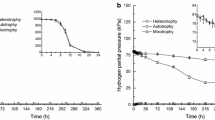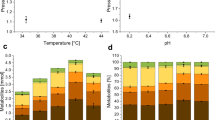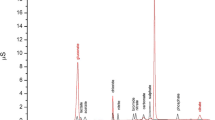Abstract
Candida utilis CBS 621 andSaccharomyces cerevisiae CBS 8066 were grown in glucose-limited chemostat cultures with formate as an additional energy source. In both yeasts formate was oxidized via a cytoplasmic NAD+-linked formate dehydrogenase. Other formate-oxidizing enzymes could not be detected.
WithCandida utilis the steady-state cell yield on glucose increased with increasing amounts of formate in the medium until growth became carbon-limited. The maximum growth yield on glucose in the presence of excess formate was dependent on the nitrogen source used for growth. With ammonium and nitrate the maximum yields were 0.69 and 0.56 g cells/g glucose, respectively. Calculations showed that this difference correlates with the NADPH requirement for biomass formation with these two nitrogen sources. This implies that the NADH produced from formate oxidation cannot replace the NADPH needed for biomass formation. It therefore is concluded that inCandida utilis transhydrogenase activity is absent.
AlsoSaccharomyces cerevisiae was capable of oxidizing formate in glucose-limited chemostat cultures. However, in contrast toCandida utilis utilization of formate by this yeast did not enhance the cell yield on glucose.
Similar content being viewed by others
References
Babel W, Müller RH, Markuske KD (1983) Improvement of growth yield of yeast on glucose to the maximum by using an additional energy source. Arch Microbiol 136:203–208
Bruinenberg PM, van Dijken JP, Scheffers WA (1983a) A theoretical analysis of NADPH production and consumption in yeasts. J Gen Microbiol 129:953–964
Bruinenberg PM, van Dijken JP, Scheffers WA (1983b) An enzymic analysis of NADPH production and consumption inCandida utilis. J Gen Microbiol 129:965–971
Dijkhuizen L, Groen L, Harder W, Konings WN (1977) Active transport of oxalate byPseudomonas oxalaticus OX1. Arch Microbiol 115:223–227
Dijkhuizen L, Timmerman JWC, Harder W (1979) A pyridine nucleotide-independent membrane-bound formate dehydrogenase inPseudomonas oxalaticus OX1. FEMS Microbiol Lett 6:53–56
Harder W, Visser K, Kuenen JG (1974) Laboratory fermenter with an improved magnetic driye. Lab Practice 23:644–645
Hazeu W, Donker RA (1983) A continuous culture study of methanol and formate utilization by the yeastPichia pastoris. Biotechn Lett 5:399–404
Lang E, Lang H (1972) Spezifische Farbreaktion zum direkten Nachweis der Ameisensäure. Z Anal Chem 260:8–10
Lloyd D (1974) The mitochondria of microorganisms. Academic Press. London New York San Francisco
Oura E (1972) The effect of aeration on the growth energetics and biochemical composition of baker's yeast. Ph.D. thesis, University of Helsinki
Sahm H, Roggenkamp R, Wagner F, Hinkelmann W (1975) Microbodies in methanol-grownCandida boidinii. J Gen Microbiol 88:218–222
Tanaka A, Yasuhara S, Kawamoto S, Fukui S, Osumi M (1976) Development of microbodies in the yeastKloeckera growing on methanol. J Bacteriol 126:919–927
Van Dijken JP, Harder W (1975) Growth yields of microorganisms on methanol and methane. A theoretical study. Biotechnol Bioeng 17:15–30
Van Verseveld HW, Boon JP, Stouthamer AH (1979) Growth yields and the efficiency of oxidative phosphorylation ofParacoccus denitrificans during two-(carbon)substrate-limited growth. Evidence for the induction of site 3 phosphorylation by methanol in heterotrophically grown cells. Arch Microbiol 121:213–223
Veenhuis M, van Dijken JP, Harder W (1983) The significance of peroxisomes in the metabolism of one-carbon compounds in yeasts. Adv Microbial Physiol 24:1–82
Von Jagow G, Klingenberg M (1970) Pathways of hydrogen in mitochondria ofSaccharomyces carlsbergensis. Eur J Biochem 12:583–592
Author information
Authors and Affiliations
Rights and permissions
About this article
Cite this article
Bruinenberg, P.M., Jonker, R., van Dijken, J.P. et al. Utilization of formate as an additional energy source by glucose-limited chemostat cultures ofCandida utilis CBS 621 andSaccharomyces cerevisiae CBS 8066. Arch. Microbiol. 142, 302–306 (1985). https://doi.org/10.1007/BF00693408
Received:
Accepted:
Issue Date:
DOI: https://doi.org/10.1007/BF00693408




